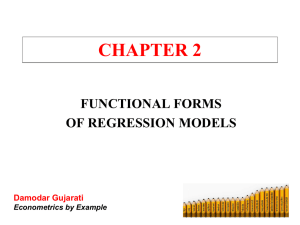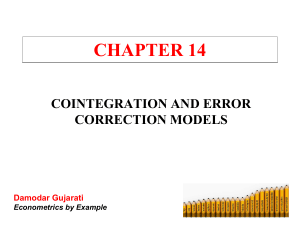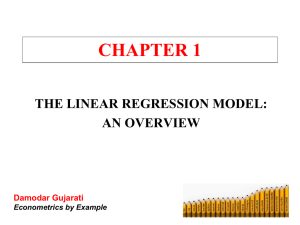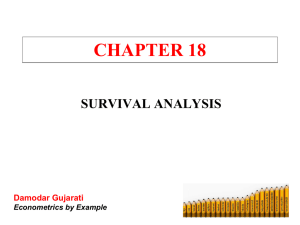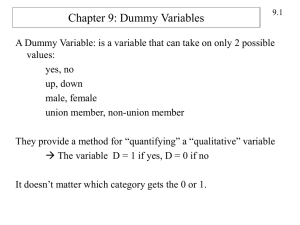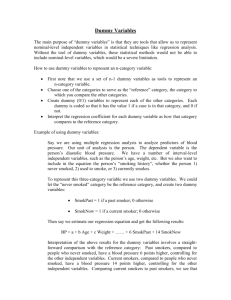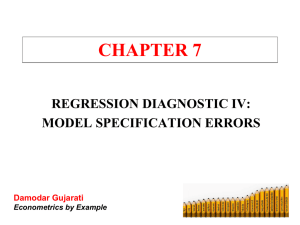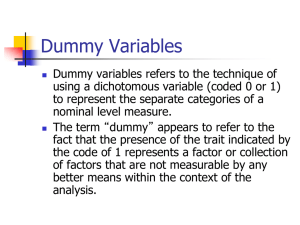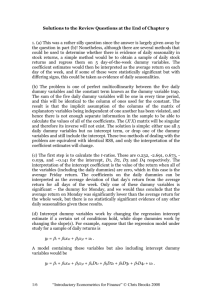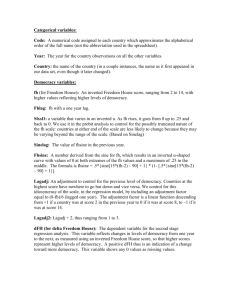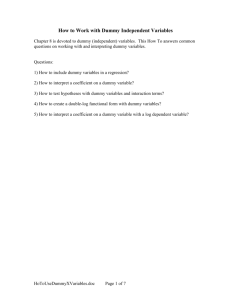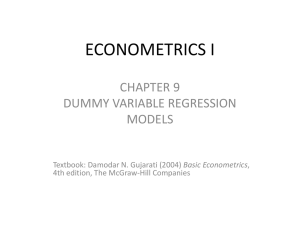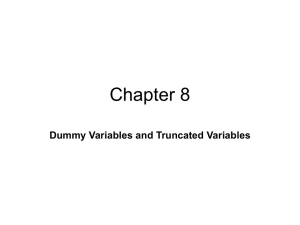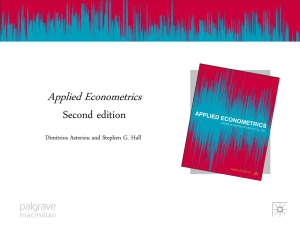Chapter 3 - Facultypages.morris.umn.edu
advertisement
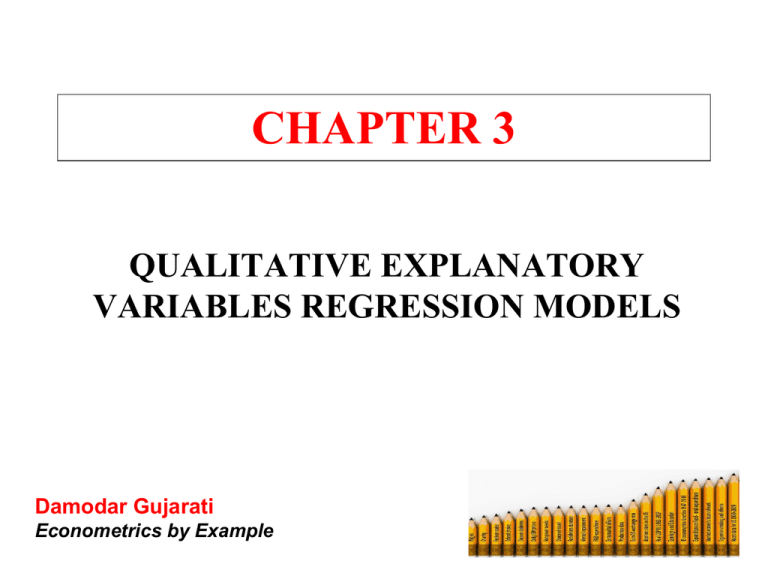
CHAPTER 3 QUALITATIVE EXPLANATORY VARIABLES REGRESSION MODELS Damodar Gujarati Econometrics by Example QUALITATIVE VARIABLES Qualitative variables are nominal scale variables which have no particular numerical values. We can “quantify” them by creating the so-called dummy variables, which take values of 0 and 1 0 indicates the absence of an attribute 1 indicates the presence of the attribute For example, a variable denoting gender can be quantified as female = 1 and male = 0 or vice versa. Dummy variables are also called indicator variables, categorical variables, and qualitative variables. Examples: gender, race, color, religion, nationality, geographical region, party affiliation, and political upheavals Damodar Gujarati Econometrics by Example DUMMY VARIABLE TRAP If an intercept is included in the model and if a qualitative variable has m categories, then introduce only (m – 1) dummy variables. For example, gender has only two categories; hence we introduce only one dummy variable for gender. This is because if a female gets a value of 1, ipso facto a male gets a value of zero. If we consider political affiliation as choice among Democratic, Republican and Independent parties, we can have at most two dummy variables to represent the three parties. If we do not follow this rule, we will fall into what is called the dummy variable trap, the situation of perfect collinearity. Damodar Gujarati Econometrics by Example REFERENCE CATEGORY The category that gets the value of 0 is called the reference, benchmark, or comparison category. All comparisons are made in relation to the reference category. If there are several dummy variables, you must keep track of the reference category; otherwise, it will be difficult to interpret the results. Damodar Gujarati Econometrics by Example POINTS TO KEEP IN MIND If there is an intercept in the regression model, the number of dummy variables must be one less than the number of classifications of each qualitative variable. If you drop the (common) intercept from the model, you can have as many dummy variables as the number of categories of the dummy variable. The coefficient of a dummy variable must always be interpreted in relation to the reference category. Dummy variables can interact with quantitative regressors as well as with qualitative regressors. If a model has several qualitative variables with several categories, introduction of dummies for all the combinations can consume a large number of degrees of freedom. Damodar Gujarati Econometrics by Example INTERPRETATION OF DUMMY VARIABLES Dummy coefficients are often called differential intercept dummies, for they show the differences in the intercept values of the category that gets the value of 1 as compared to the reference category. The common intercept value refers to all those categories that take a value of 0. Damodar Gujarati Econometrics by Example INTERPRETATION OF DUMMY VARIABLES If we have: Yi = B1 + B2 Fi where Y = wage and F = female dummy variable Then, on average, females earn a wage of (B1 + B2) and males earn a wage of B1. (Note that B2 can be negative.) Thus females earn a wage that is B2 higher than males. Since wages tend to be skewed to the right, we might instead model the wage function as: lnYi = B1 + B2 Fi In this case, females earn (eB2 – 1)*100% more than males on average. On average, male wages are equal to eB1, and female wages are equal to e(B1+B2). Damodar Gujarati Econometrics by Example USE OF DUMMY VARIABLES IN SEASONAL DATA The process of removing the seasonal component from a time series is called deseasonlization or seasonal adjustment The resulting time series is called deseasonalized or seasonally adjusted time series. Consider the following model predicting the sales of fashion clothing: Salest A1 A2 D2t A3 D3t A4 D4t ut where D2 =1 for second quarter, D3 =1 for third quarter, D4= 1 for 4th quarter, Sales = real sales per thousand square feet of retail space. Damodar Gujarati Econometrics by Example USE OF DUMMY VARIABLES IN SEASONAL DATA In order to deseasonalize the sales time series, we proceed as follows: 1. From the estimated model we obtain the estimated sales volume. 2. Subtract the estimated sales value from the actual sales volume and obtain the residuals. 3. To the estimated residuals, we add the (sample) mean value of sales. The resulting values are the deseasonalized sales values. Damodar Gujarati Econometrics by Example FRISCH-WAUGH THEOREM By introducing the seasonal dummies in the model we deseasonalize all the time series used in the model If variables are subject to prior adjustment by ordinary least squares and the residuals are subsequently used in a regression equation, then the resulting estimates are identical to those from a regression which uses unadjusted data but uses the adjustment variables explicitly. Damodar Gujarati Econometrics by Example
